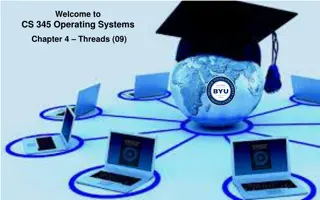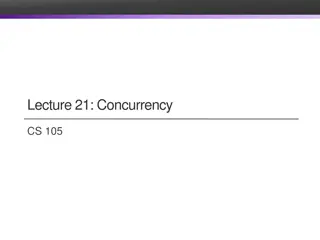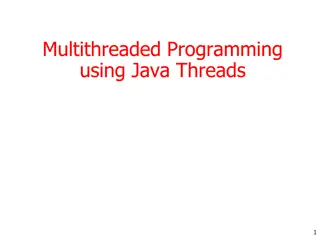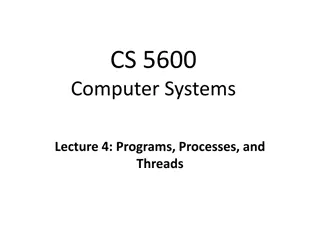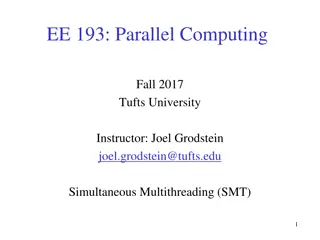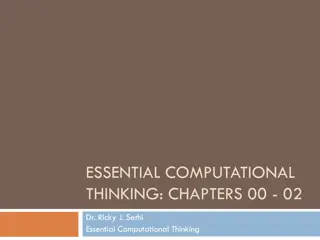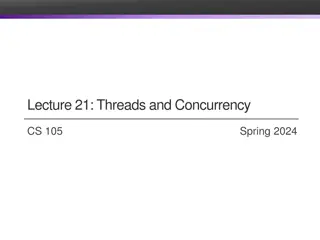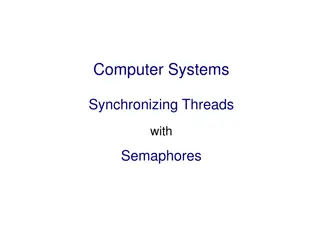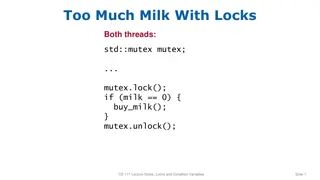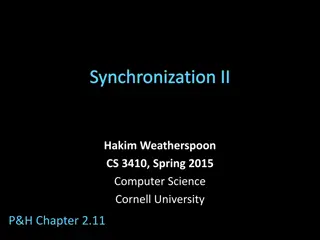Threads in Computer Science
Threads play a vital role in enhancing application performance through parallel execution. They enable efficient communication within a process, minimize context switching time, and allow for utilization of multiprocessor architectures. Learn about types of threads, advantages of threading, and how threads are implemented at user and kernel levels.
Download Presentation

Please find below an Image/Link to download the presentation.
The content on the website is provided AS IS for your information and personal use only. It may not be sold, licensed, or shared on other websites without obtaining consent from the author.If you encounter any issues during the download, it is possible that the publisher has removed the file from their server.
You are allowed to download the files provided on this website for personal or commercial use, subject to the condition that they are used lawfully. All files are the property of their respective owners.
The content on the website is provided AS IS for your information and personal use only. It may not be sold, licensed, or shared on other websites without obtaining consent from the author.
E N D
Presentation Transcript
What is Thread? A thread is a flow of execution through the process code, with its own program counter that keeps track of which instruction to execute next, system registers which hold its current working variables, and a stack which contains the execution history. A thread shares with its peer threads few information like code segment, data segment and open files. When one thread alters a code segment memory item, all other threads see that. A thread is also called a lightweight process. Threads provide a way to improve application performance through parallelism.
Each thread belongs to exactly one process and no thread can exist outside a process. Each thread represents a separate flow of control. Threads have been successfully used in implementing network servers and web server. They also provide a suitable foundation for parallel execution of applications multiprocessors. The following figure shows the working of a single- threaded and a multithreaded process. on shared memory
Advantages of Thread Threads minimize the context switching time. Use of threads provides concurrency within a process. Efficient communication. It is more economical to create and context switch threads. Threads allow utilization of multiprocessor architectures to a greater scale and efficiency.
Types of Thread Threads are implemented in following two ways User Level Threads User managed threads. Kernel Level Threads Operating System managed threads acting on kernel, an operating system core.
User Level Threads In this case, the thread management kernel is not aware of the existence of threads. The thread library contains code for creating and destroying threads, for passing message and data between threads, for scheduling thread execution and for saving and restoring thread contexts. The application starts with a single thread.
Advantages Thread switching does not require Kernel mode privileges. User level thread can run on any operating system. Scheduling can be application specific in the user level thread. User level threads are fast to create and manage.
Disadvantages In a typical operating system, most system calls are blocking. Multithreaded application cannot take advantage of multiprocessing.
Kernel Level Threads In this case, thread management is done by the Kernel. There is no thread management code in the application area. Kernel threads are supported directly by the operating system. Any application can be programmed to be multithreaded. All of the threads within an application are supported within a single process.
The Kernel maintains context information for the process as a whole and for individuals threads within the process. Scheduling by the Kernel is done on a thread basis. The Kernel performs thread creation, scheduling and management in Kernel space. Kernel threads are generally slower to create and manage than the user threads.
Advantages Kernel can simultaneously schedule multiple threads from the same process on multiple processes. If one thread in a process is blocked, the Kernel can schedule another thread of the same process. Kernel routines themselves can be multithreaded.
Disadvantages Kernel threads are generally slower to create and manage than the user threads. Transfer of control from one thread to another within the same process requires a mode switch to the Kernel.
Difference between User-Level & Kernel-Level Thread





